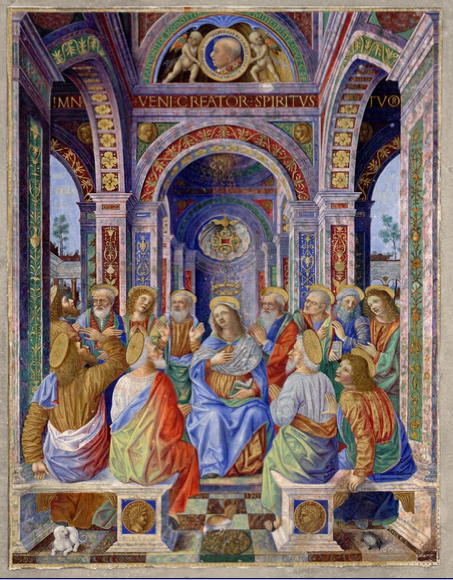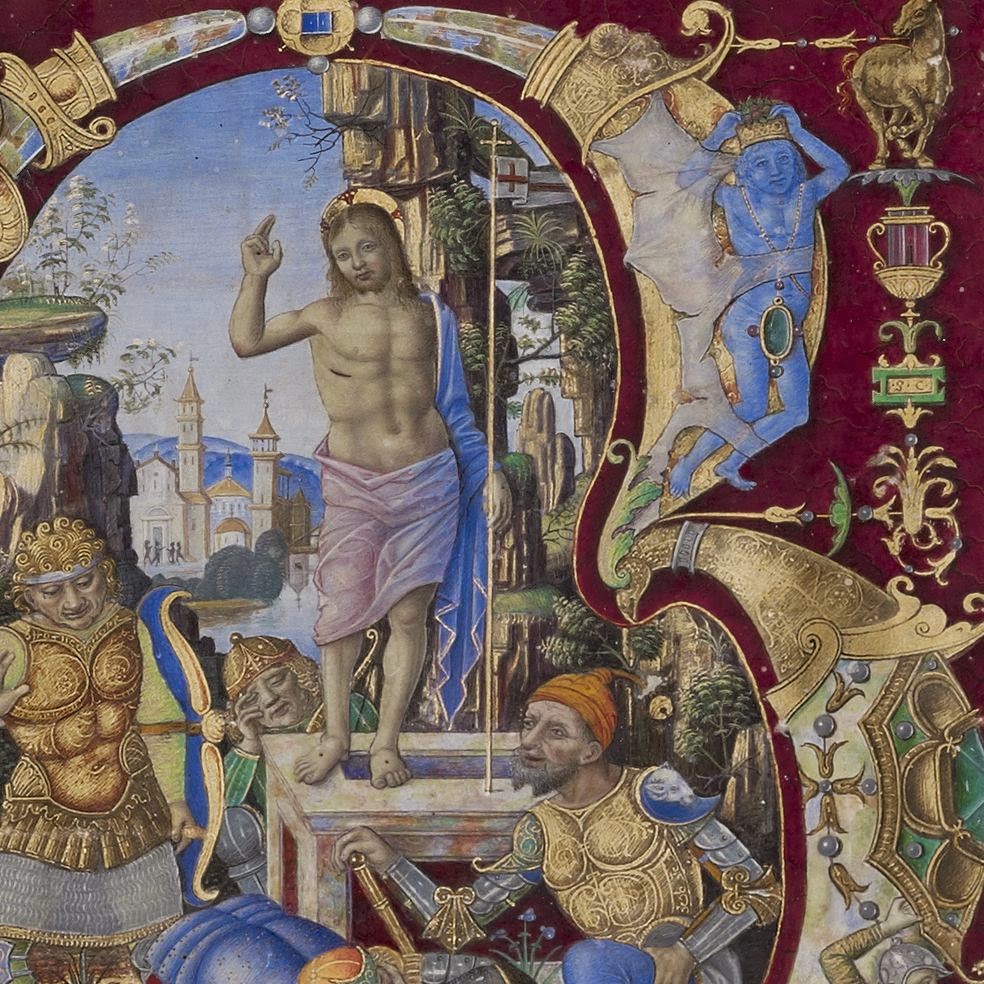Nicolas Poussin (1594-1665)
La Vision de sainte Françoise Romaine: The Vision of Saint Francesca Romana
c. 1657
Oil on canvas
120,7 x 101,8 cm
Musée du Louvre, Paris
Over three quarter of Poussin`s paintings have religious subjects
This has come as a surprise to some art historians who see him as a Classicist mainly concerned with pre-Christian Rome and Greece
On the face of it the exhibition is to mark the 350th anniversary of the artist's death in 1665
The exhibition tries to review possible Christian readings of Poussin's painting and one of his signature features: his merging of the antique and Christian notions of the sacred
Poussin’s religious paintings have been studied far less than his secular works, largely due to the image of the artist that some art historians (in particular
Anthony Blunt) have created
The result is often to see his works as works of the intellect and only fully appreciated through intellectual lenses
He resided in baroque Rome, in the period that followed the Council of Trent.
According to Cardinal Gabriele Paleotti's Discorso, the proper purpose of religious art was: 'il dilettare, l'insegnare, e commovere'
Teaching may have been one purpose but as Paleotti pointed out the senses, interest and emotions of the spectator were also to be engaged
In addition to straight forward religious themes, he also used religious motifs in his mythological works.
For Blunt, Poussin is the great Stoic. Animated by great passion which is concentrated by serious intelligence, reason and the will
« Le Peintre philosophe ... le maître du classicisme» who painted the « paysage idéal »
That is an element of his work but not the whole story
The work was commissioned to celebrate the ending of an outbreak of the plague in Rome in 1656 - 7
Poussin’s niece and sister-in-law died in the outbreak in Rome
In 1656, the plague killed about half of Naples' 300,000 inhabitants. It was
the worst disaster to strike the kingdom and city of Naples in the 1600s
St Francesca or St Frances was known by the people of Rome as "the Advocate of Rome"
Her intervention had been sought to end the plague and by 1657 the virulence of the epidemic had substantially decreased and it looked as if it was about to be eradicated
There are two possible interpretations of the work according to the Louvre catalogue
First, the Saint is appearing to a Roman lady or Carmelite (possibly Anna Colonna Barberini, founder of the convent and the Carmelite cchurch of Regina Coeli in Rome at this time) who is beseeching her to intervene and entreat the end of the plague
The alternative but far more likely explanation is that St Frances on behalf of the City of Rome is the one who is kneeling and appealing to Our Lady to entreat her Son to end the plague
This is probably more likely as the figure of the Virgin is based on the cult of the city of Faenza to the
Beata Vergine delle Grazie
Faenza’s Beata Vergine delle Grazie emerged during the plague epidemic of 1410, when a woman named Giovanna de’ Costumi prayed to the Virgin for her city’s liberation
The Virgin Mary appeared to her, opened her arms in the manner of the crucified Christ, and, while breaking the arrows she held in each hand
The cult grew again in Faenza in 1630 and it would seem that the city was spared from the plague
The cult spread to Rome and Cardinal Giulio Rospigliosi was a member of the Confraternity of the Beata Vergine delle Grazie
This interpretation fits in with the idea of the painting being an e
x voto
Arrows ? A classical reference.
Apollo was the pagan God who among other things brought
plague through firing arrows
In Homer's
Iliad I, 39, Apollo shoots the arrows of plague at the Greeks for nine days: “with a face as dark as night, and his silver bow rang death as he shot his arrow in the midst of them.”
Apollo's many epithets included “
Smintheus,” associated with mice and rats, both as their exterminator, but also as the bringer of the plague.
We see the angel chasing Apollo or his minion away like a giant mouse or rat back into the earth or ground whence the mice came
The mouse in ancient times was a symbol of prophetic power because it was thought mice were inspired by the exhaling coming out of the ground.
Here we see Mary surrounded by clouds or fumes like an Ancient Prophetess prophesying the end of the plague to the saint. No tripod. She dispels the fumes coming from the ground which the ancient sibyls relied on to prophesy. She overcomes the ancient pagan dispensation of evil soothsayers who scurry off stage right
The role of
Mary as Prophet is seen in the New Testament in
Luke 1:26-55- in the Canticle of Mary at the Visitation
We see it also in Lourdes and Fatima
In the background of the painting we see scenes of the plague and an archangel putting to flight a monster who personifies the Great Affliction
The scene is set in imposing architecture marked by classical pilasters framing a large arcade.
The scene is Rome
The figure of the Plague has the features of the Gladiator carrying a dead child and another, (based on the ancient statues in the Farnese collection now in the Archaeological Museum in Naples).
The cult of Faenza becomes a cult of Rome
Mary is seen in her role as the mediatrix of Grace between human and divine. A Jesuit theme and certainly not Jansenist
Saint John Paul II once said:
"As the liturgy and Christian piety demonstrate, the Church has always held devotion to Mary in high esteem, considering it inseparably linked to belief in Christ. It is in fact based on the Father’s plan, the Saviour’s will and the Paraclete’s inspiration."
The importance of "popular piety" has always been emphasised by the Church. Pope Francis wrote in
Evangelii Gaudium:
"Popular piety enables us to see how the faith, once received, becomes embodied in a culture and is constantly passed on. Once looked down upon, popular piety came to be appreciated once more in the decades following the Council. In the Exhortation Evangelii Nuntiandi, Pope Paul VI gave a decisive impulse in this area. There he stated that popular piety “manifests a thirst for God which only the poor and the simple can know” and that “it makes people capable of generosity and sacrifice even to the point of heroism, when it is a question of bearing witness to belief”. Closer to our own time, Benedict XVI, speaking about Latin America, pointed out that popular piety is “a precious treasure of the Catholic Church”, in which “we see the soul of the Latin American peoples”.
During the outbreak the Pope, Alexander VII stayed in the Quirinal
With the Congregazione della sanità strict health preventive measures were adopted and enforced
In July 1656, most of Romes distinguished artists and architects were invited to take up residence on the barricaded grounds of the Quirinal Palace
However Poussin appears to have stayed with his beloved wife Anne-Marie and his extended family
It would have been a fraught and anxious time to say the least
During the plague the Pope expressly entrusted the city to Our Lady
And during the plague time Poussin executed another work to Mary: The Annunciation (1657) which is in The National Gallery in London
Some have called it his greatest work
Nicolas Poussin (1594-1665)
The Annunciation
1657
Oil on canvas
106 x 104 cm
National Gallery, London
It is an austere work as one might expect in a time of plague which theologians of the time attributed to the effects of Original Sin and the Fall of Man
It has been suggested that the picture was intended to hang above the tomb of Poussin's patron, Cassiano dal Pozzo (1588 - 1657), in the church of Santa Maria sopra Minerva, Rome.
Another possibility is that it was painted for Pope Alexander VII and for his private chapel at the Quirinal
Mary has a yellow shawl. Yellow was the colour which the Jews in Rome were compelled to wear at that time to distinguish them from other Romans
Rather ironically, Poussin used "Naples Yellow" (lead antimony yellow) a pigment of unusual origin with a touch of tin for the colour
In the 17th century, Naples yellow was a native earth associated only with Vesuvius and its environs as part of an attempt by makers to throw off how it was made
This is quite definitely a Mary of the Jewish faith
She is reading The Old Testament - the Word of God
It is soon to be given to her the choice to conceive The Word
She is meditating on it. She is praying
Or as said by Luke, she is pondering
The scene is narrated in Luke:
"In the sixth month the angel Gabriel was sent by God to a town in Galilee called Nazareth,to a virgin engaged to a man whose name was Joseph, of the house of David. The virgin’s name was Mary. And he came to her and said, ‘Greetings, favoured one! The Lord is with you.’ But she was much perplexed by his words and pondered what sort of greeting this might be. The angel said to her, ‘Do not be afraid, Mary, for you have found favour with God. And now, you will conceive in your womb and bear a son, and you will name him Jesus’ (Luke 1.26-31).
Anthony Blunt argued that the work borrows from
The Ecstasy of St Teresa sculpted by Bernini for the Coronaro Chapel in Rome
But the love here bears no trace of the erotic love depicted in Bernini`s work
We see agape
We see a Lady filled with Grace, that concept whose discussion led to a rupture in Christendom and whose debates were filled with hate and bitterness spilling over and developing into devastating conflicts which wracked European Christendom in the beginning of the 17th century
The conflagrations and wars were not about Grace but territory and treasure, The material, interest and power not spirit and certainly not about love and service.
In the painting we see Mary is seated like the Seat of Wisdom and over her is the Holy Spirit, that person of the Trinity whose acts are " those in which Love excels"
Perhaps this image brings to mind Scripture:
"That which is born of the Spirit, is spirit" (John iii., 6).
"Send forth Thy Spirit and they shall be created, and Thou shalt renew the face of the earth" (Ps. ciii., 30).
Unlike one of
Fra Angelico`s Annunciations, this Annunciation is a lean spare and powerful statement of the essential meaning of that most mysterious and most important event when Mary assented to the will of God and the countdown to Man`s redemption began



























.jpg)
.jpg)
.jpg)
.jpg)
.jpg)
.jpg)
.jpg)
.jpg)
